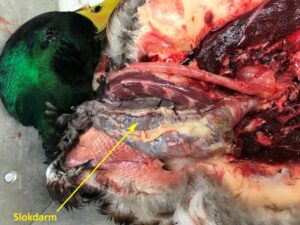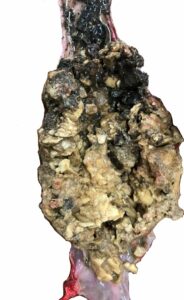

In a duck decoy in the north of the province of North-Holland, a forester from Staatsbosbeheer reported mid-January 2019 a weakened mallard (Anas platyrhynchos) with puffed-up feathers, gasping for breath, and just died. In the week before he had also had found three dead mallards in the duck decoy. Two of these animals were in good condition and had bulb left-overs in their crops.
The 4th Mallard that just died was collected by DWHC for post-mortem investigation. This duck was well fed as well. The crop and the oesophagus were excessively filled with bulbs. The overfilled oesophagus was blocking the windpipe which caused the mallard to choke.
The bulbs were remnants of greenhouses that force bulbs like tulips into bloom. These bulbs are shriveled and, together with potting compost, dumped on a pile to be used later on the land. It is known that in winter animals, such as roe deer and geese gratefully eat of the bulbs. Because bulb piles produce heat, they don’t freeze and remain therefore suitable as a food source. Apparently mallards also eat from the bulbs. During daytime, mallards use lakes, ponds, and ditches to rest. They forage in the evening and at night. During the day a duck decoy is full of resting mallards. Because these four mallards were in a duck decoy, their odd behaviour (puffed-up feathers, gasping for breath) could be noticed and were the dead ducks found.
 |
 |
| Mallard with an excessively filled oesophagus (‘slokdarm’). Photo: DWHC | The contents of the oesophagus with bulb. Photo: DWHC |